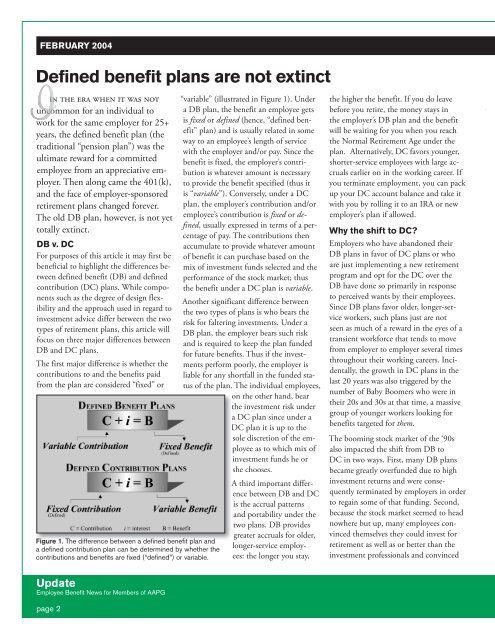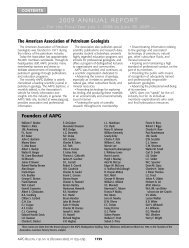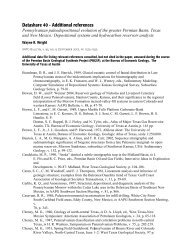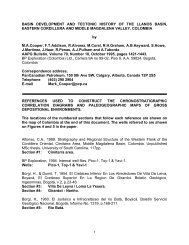S All asset categories end 2003 with positive returns - American ...
S All asset categories end 2003 with positive returns - American ...
S All asset categories end 2003 with positive returns - American ...
You also want an ePaper? Increase the reach of your titles
YUMPU automatically turns print PDFs into web optimized ePapers that Google loves.
FEBRUARY 2004<br />
Defined benefit benefit plans plans are are not not extinct<br />
extinct<br />
I<br />
I Iin in the the era era when when it it was was not<br />
not<br />
Iuncommon<br />
Iwork<br />
Iuncommon<br />
Iwork<br />
Iwork<br />
Iuncommon<br />
Iwork<br />
Iwork<br />
Iuncommon<br />
Iwork<br />
Iuncommon<br />
Iwork<br />
Iwork<br />
uncommon for for an an in in di di vid vid u u al al to<br />
to<br />
work for for the the same same em em ploy ploy er er for for 25+<br />
25+<br />
years, the defined benefit plan (the<br />
traditional “pen sion plan”) was the<br />
ultimate reward for a committed<br />
employee from an appreciative employ<br />
er. Then along came the 401(k),<br />
and the face of employer-sponsored<br />
retirement plans changed forever.<br />
The old DB plan, however, is not yet<br />
totally extinct.<br />
DB v. DC<br />
For purposes of this article it may first be<br />
beneficial to highlight the differences between<br />
defined benefit (DB) and de fined<br />
contribution (DC) plans. While components<br />
such as the degree of design flexi<br />
bil i ty and the ap proach used in re gard to<br />
in vest ment advice differ between the two<br />
types of retirement plans, this ar ti cle will<br />
fo cus on three ma jor dif fer enc es be tween<br />
DB and DC plans.<br />
The first major dif fer ence is whether the<br />
con tri bu tions to and the benefits paid<br />
from the plan are con sid ered “fixed” or<br />
Figure 1. The difference between a defi ned benefi t plan and<br />
a defi ned contribution plan can be determined by whether the<br />
contributions and benefi ts are fi xed (“defi ned”) or variable.<br />
Update<br />
Employee Benefi t News for Members of AAPG<br />
page 2<br />
“vari able” (il lus trat ed in Fig ure 1). Un der<br />
a DB plan, the ben e fit an em ploy ee gets<br />
is fixed or de fined (hence, “de fined benefit”<br />
plan) and is usu al ly re lat ed in some<br />
way to an em ploy ee’s length of service<br />
<strong>with</strong> the em ploy er and/or pay. Since the<br />
ben e fit is fixed, the employer’s con tri -<br />
bu tion is what ev er amount is nec es sary<br />
to pro vide the ben e fit spec i fied (thus it<br />
is “vari able”). Conversely, under a DC<br />
plan, the em ploy er’s con tri bu tion and/or<br />
em ploy ee’s con tri bu tion is fixed or defined,<br />
usu al ly ex pressed in terms of a percent<br />
age of pay. The con tri bu tions then<br />
ac cu mu late to pro vide what ev er amount<br />
of benefit it can pur chase based on the<br />
mix of in vest ment funds se lect ed and the<br />
per for mance of the stock mar ket; thus<br />
the ben e fit un der a DC plan is vari able.<br />
Another significant difference between<br />
the two types of plans is who bears the<br />
risk for faltering in vest ments. Under a<br />
DB plan, the em ploy er bears such risk<br />
and is required to keep the plan fund ed<br />
for fu ture ben e fits. Thus if the in vest -<br />
ments per form poor ly, the em ploy er is<br />
liable for any short fall in the fund ed status<br />
of the plan. The in di vid u al em ploy ees,<br />
on the other hand, bear<br />
the investment risk un der<br />
a DC plan since under a<br />
DC plan it is up to the<br />
sole dis cre tion of the employ<br />
ee as to which mix of<br />
investment funds he or<br />
she chooses.<br />
A third important difference<br />
between DB and DC<br />
is the accrual patterns<br />
and port a bil i ty under the<br />
two plans. DB pro vides<br />
great er ac cru als for older,<br />
long er-service employees:<br />
the longer you stay,<br />
the higher the benefit. If you do leave<br />
before you re tire, the money stays in<br />
the employer’s DB plan and the ben e fit<br />
will be wait ing for you when you reach<br />
the Normal Re tire ment Age un der the<br />
plan. Al ter na tive ly, DC fa vors young er,<br />
short er-service em ploy ees <strong>with</strong> large accru<br />
als ear li er on in the work ing career. If<br />
you terminate em ploy ment, you can pack<br />
up your DC ac count balance and take it<br />
<strong>with</strong> you by rolling it to an IRA or new<br />
em ploy er’s plan if al lowed.<br />
Why the shift to DC?<br />
Employers who have abandoned their<br />
DB plans in favor of DC plans or who<br />
are just implementing a new retirement<br />
pro gram and opt for the DC over the<br />
DB have done so primarily in response<br />
to perceived wants by their employees.<br />
Since DB plans favor older, longer-service<br />
workers, such plans just are not<br />
seen as much of a reward in the eyes of a<br />
tran sient workforce that t<strong>end</strong>s to move<br />
from em ploy er to em ploy er several times<br />
through out their working careers. Incidentally,<br />
the growth in DC plans in the<br />
last 20 years was also trig gered by the<br />
num ber of Baby Boomers who were in<br />
their 20s and 30s at that time, a mas sive<br />
group of young er work ers look ing for<br />
benefits targeted for them.<br />
The boom ing stock mar ket of the ‘90s<br />
also impacted the shift from DB to<br />
DC in two ways. First, many DB plans<br />
be came great ly overfunded due to high<br />
in vest ment re turns and were con se -<br />
quent ly ter mi nat ed by em ploy ers in or der<br />
to re gain some of that funding. Sec ond,<br />
be cause the stock market seemed to head<br />
no where but up, many em ploy ees convinced<br />
them selves they could invest for<br />
re tire ment as well as or bet ter than the<br />
in vest ment pro fes sion als and con vinced















